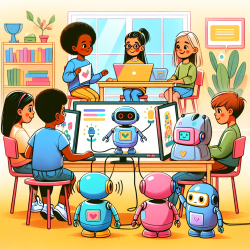Online therapy has revolutionized access to therapeutic services, but maintaining engagement and effectiveness remains a challenge, especially in educational settings. The recent research article "PAL: A Framework for Physically Assisted Learning Through Design and Exploration With a Haptic Robot Buddy" offers promising insights that can significantly enhance online therapy practices.
Understanding the PAL Framework
The PAL framework, developed by Kianzad et al., is grounded in experiential learning theory and leverages haptic technology to create interactive and engaging learning environments. The framework is based on Kolb's experiential learning cycle, which includes four stages: concrete experience, reflective observation, abstract conceptualization, and active experimentation. The focus is on using haptic feedback to enrich the stages of active experimentation and concrete experience.
Implementing PAL in Online Therapy
Here are some practical ways practitioners can implement the outcomes of this research to improve their online therapy sessions:
1. Integrating Haptic Feedback
Haptic feedback can be integrated into online therapy sessions to provide a more immersive experience. For instance, using a haptic robot buddy, therapists can simulate physical interactions that help students grasp complex concepts. This can be particularly beneficial for students with special needs who may struggle with abstract thinking.
2. Enhancing Engagement Through Interactive Learning
The PAL framework emphasizes the importance of interactive learning. Therapists can use haptic devices to create virtual experiments that students can physically interact with. This hands-on approach can make learning more engaging and help students retain information better.
3. Facilitating Reflective Observation
Encouraging students to reflect on their experiences is crucial for deeper learning. Therapists can guide students through reflective observation by asking them to describe their interactions with the haptic devices and what they learned from them. This process can help solidify their understanding and encourage critical thinking.
4. Personalizing Learning Experiences
The flexibility of the PAL framework allows therapists to tailor learning experiences to individual student needs. By adjusting the parameters of the haptic feedback and the complexity of the virtual experiments, therapists can create personalized learning paths that cater to each student's unique abilities and learning pace.
Encouraging Further Research
While the PAL framework offers a robust foundation for integrating haptic technology into online therapy, there is still much to explore. Practitioners are encouraged to conduct further research and experimentation to refine these methods and discover new applications. Collaborating with researchers and participating in studies can contribute to the growing body of knowledge in this field.
Conclusion
Implementing the PAL framework in online therapy can significantly enhance the learning experience for students, particularly those with special needs. By integrating haptic feedback, promoting interactive learning, facilitating reflective observation, and personalizing learning experiences, therapists can create more effective and engaging therapy sessions.To read the original research paper, please follow this link:
PAL: A Framework for Physically Assisted Learning Through Design and Exploration With a Haptic Robot Buddy.
